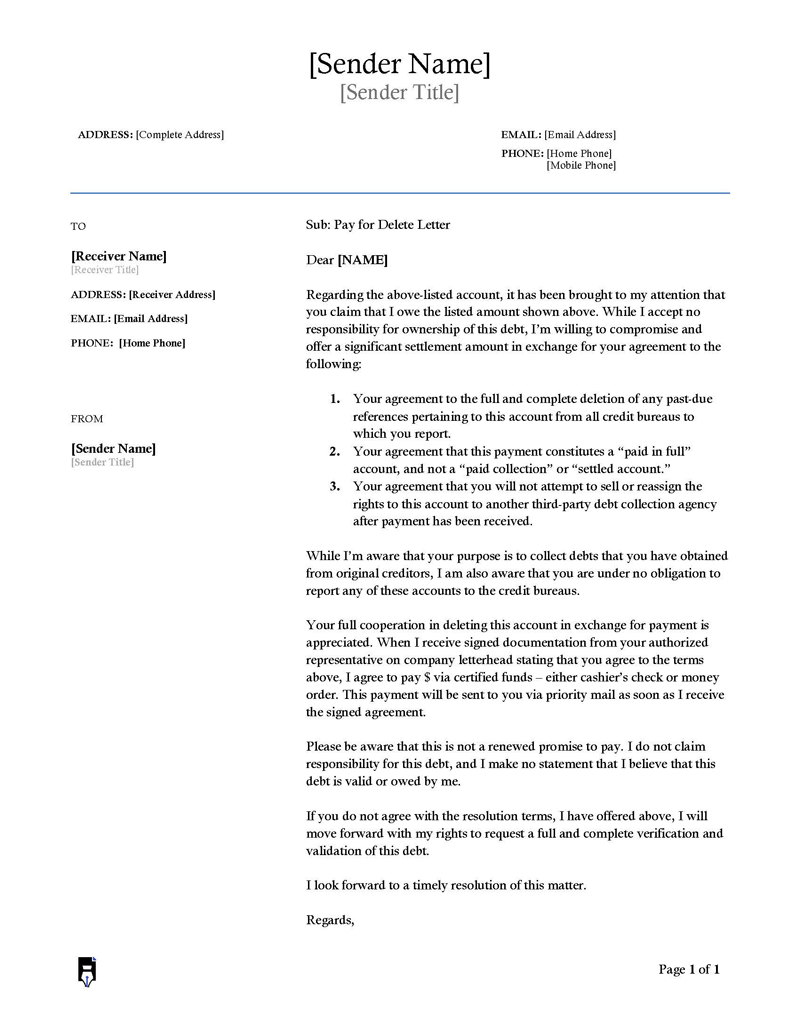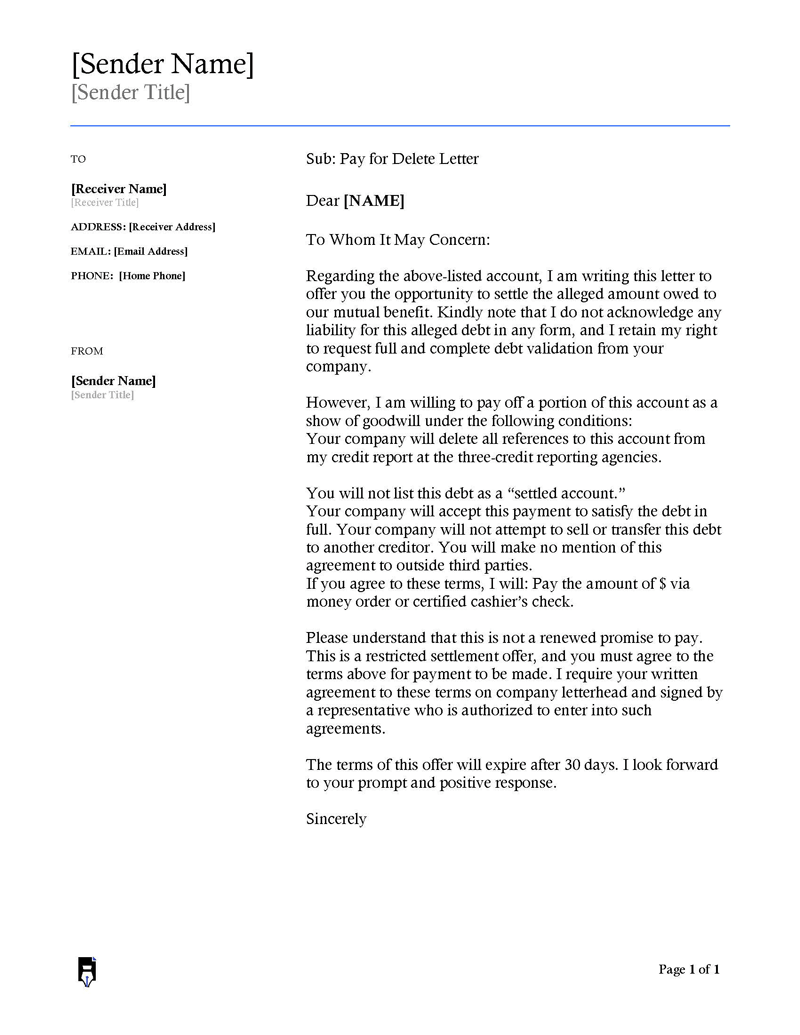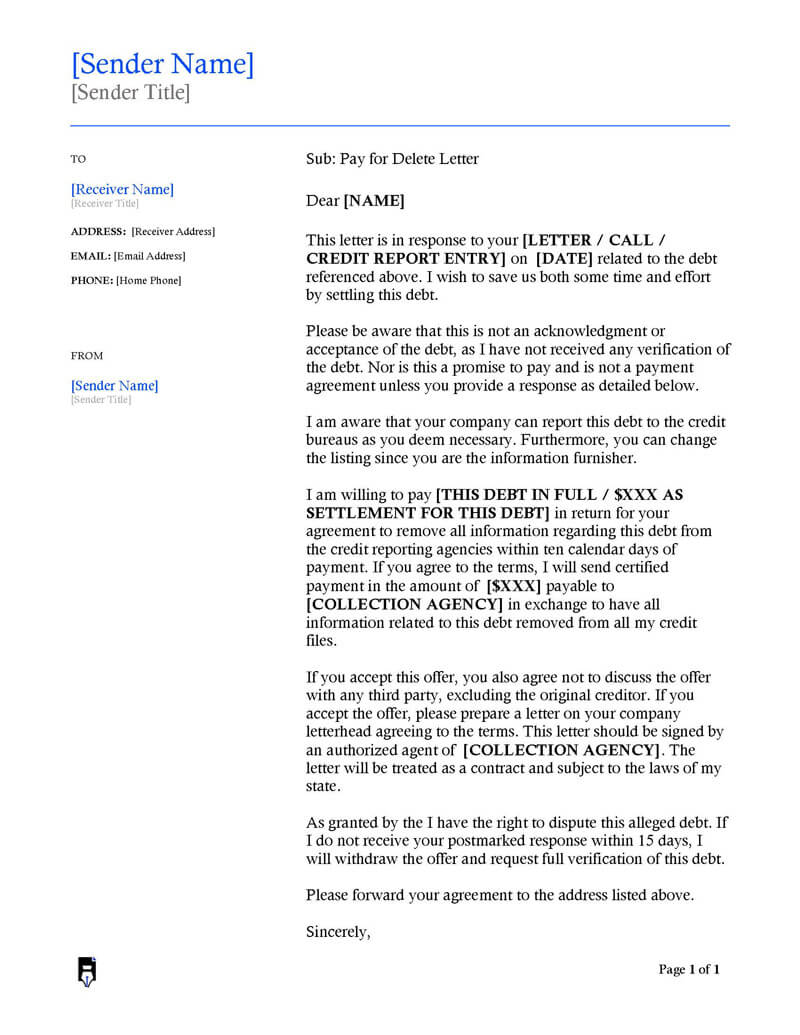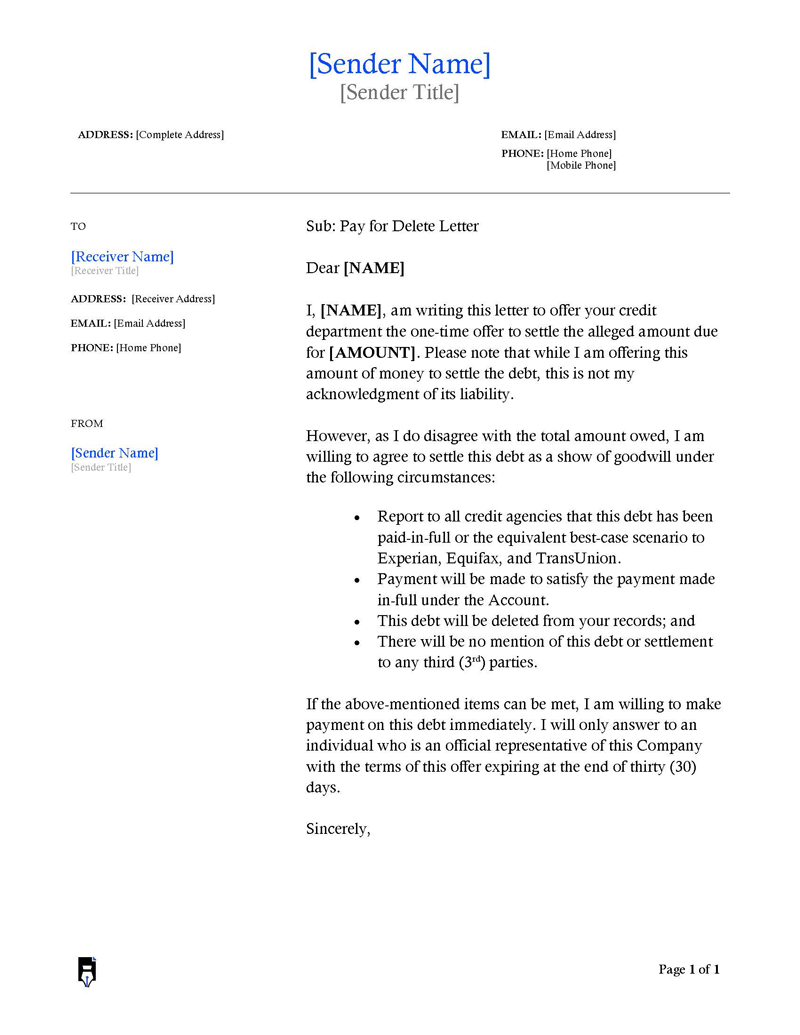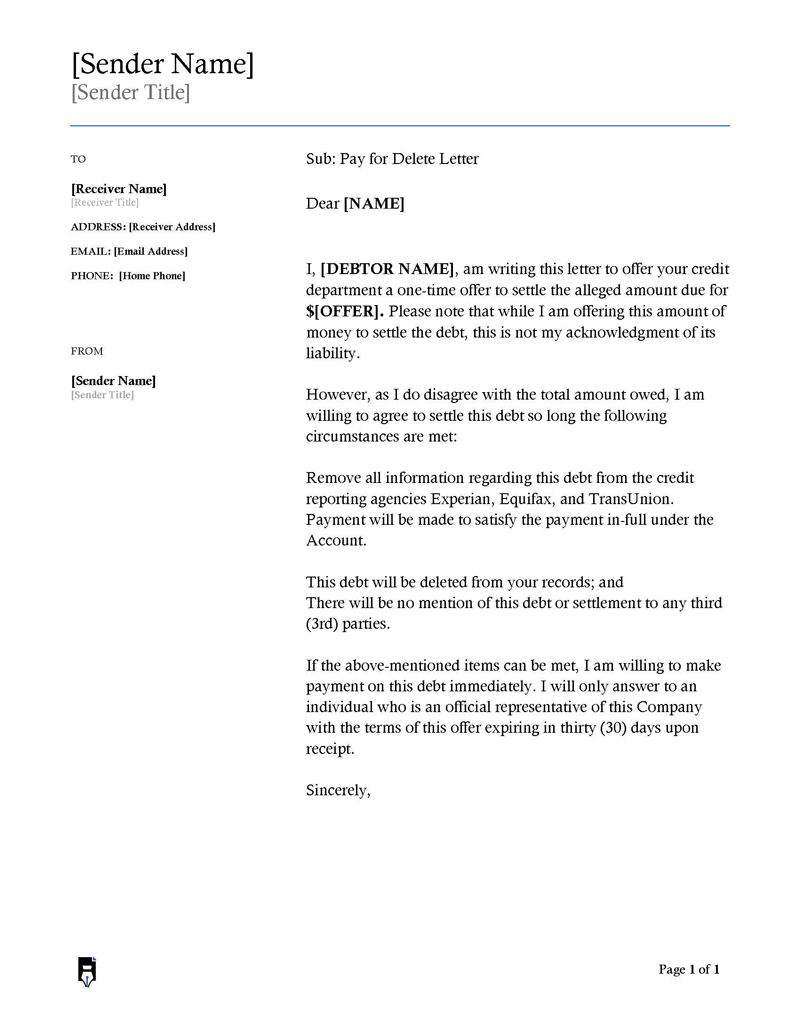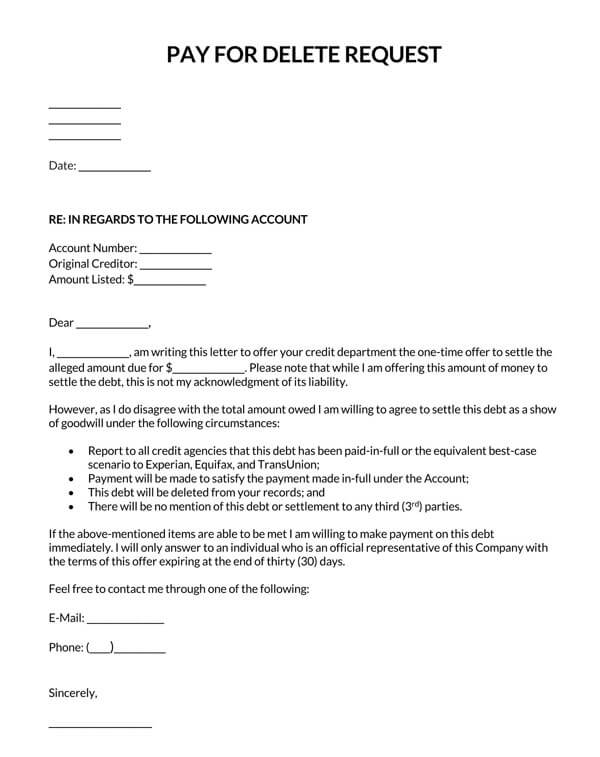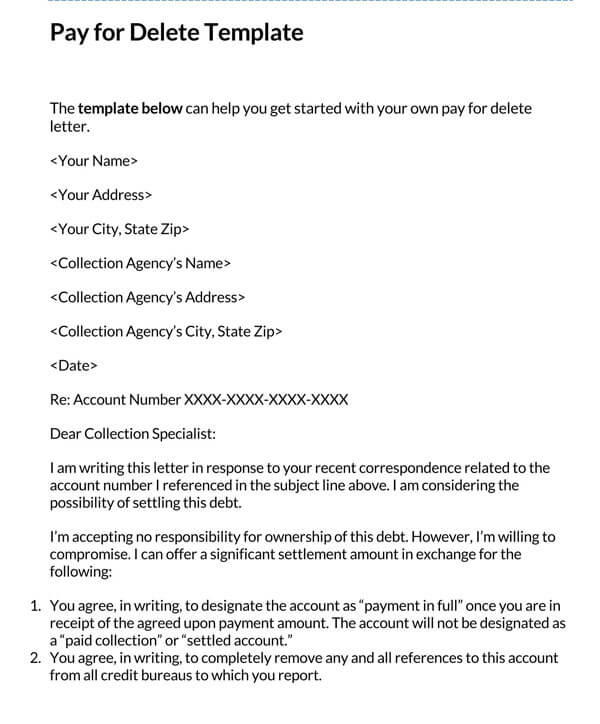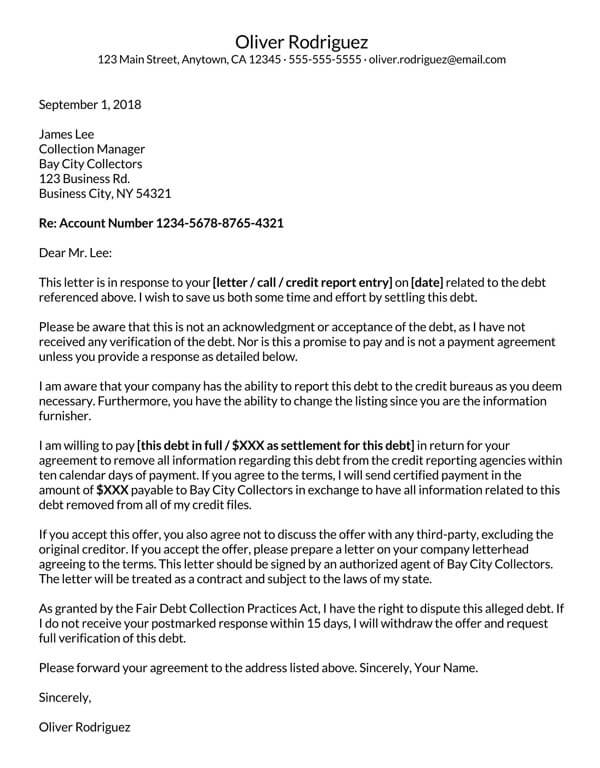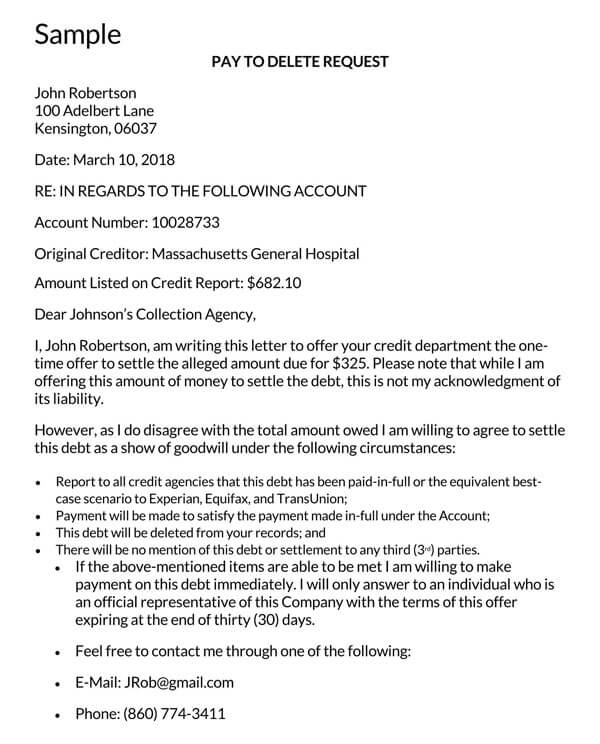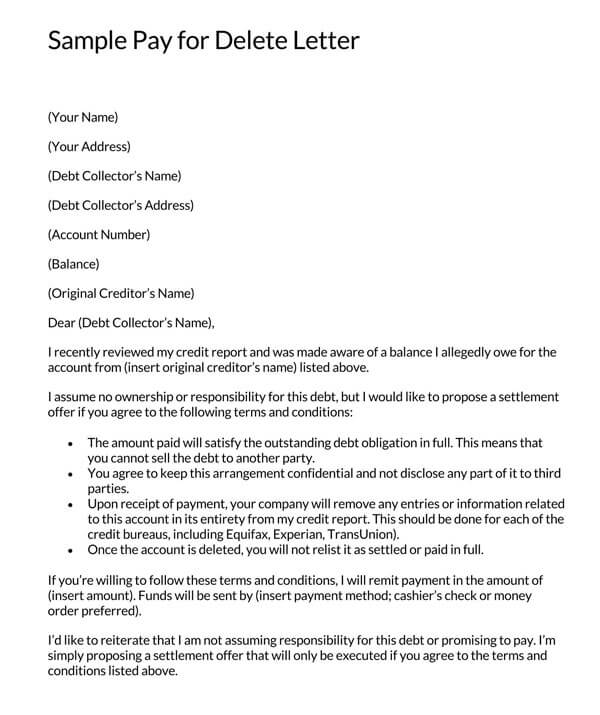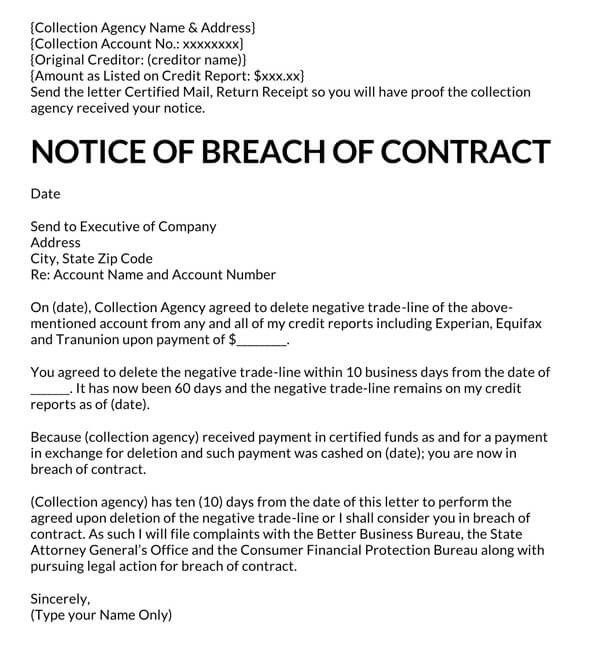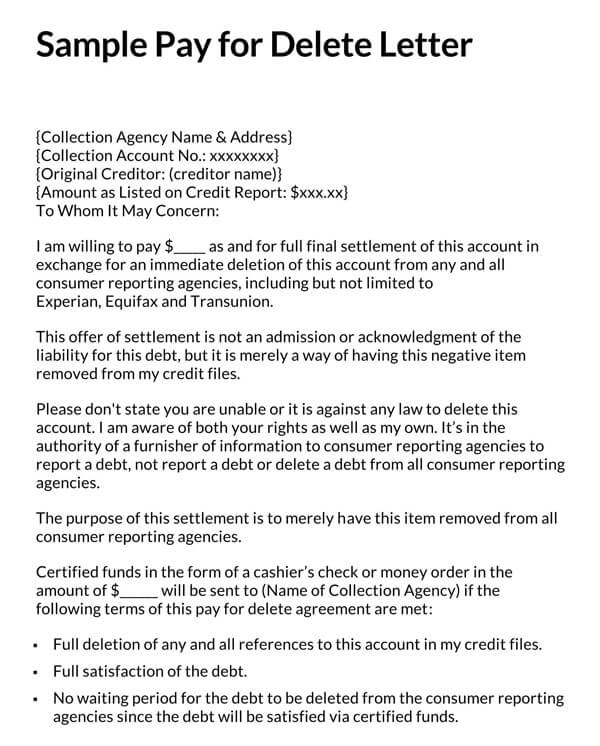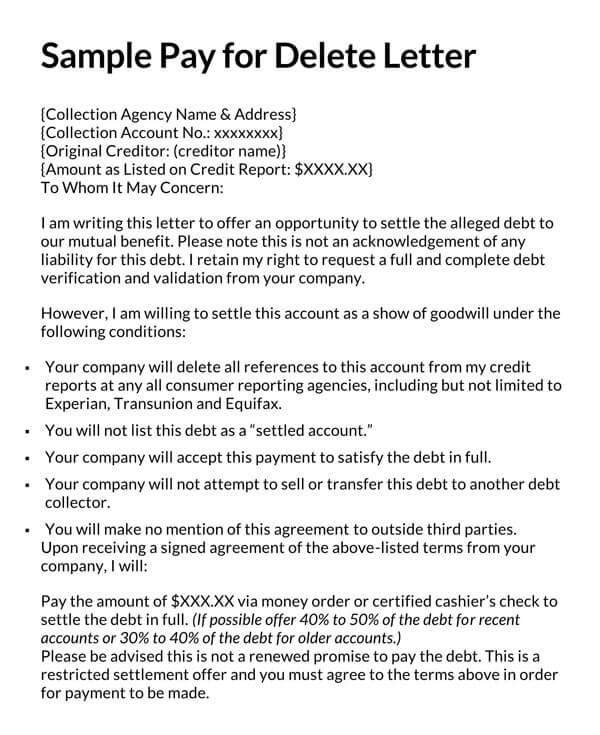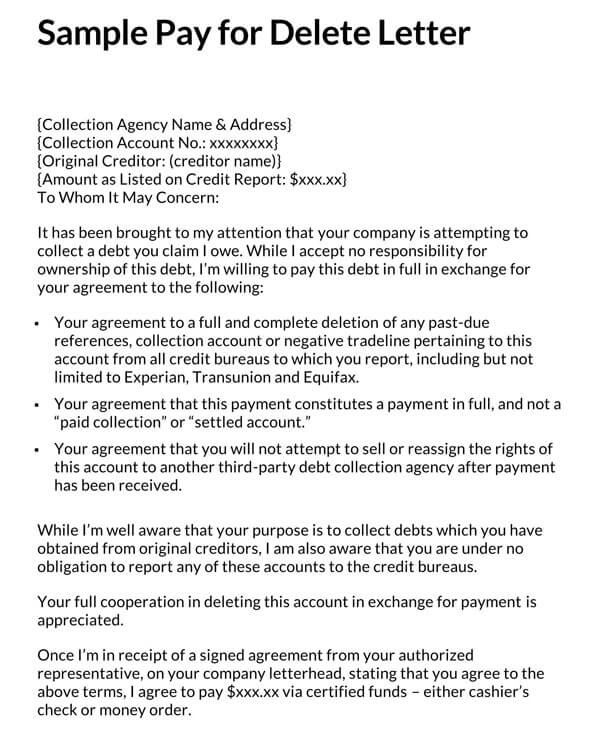A Pay for delete letter is a letter sent to a creditor by a consumer, urging the creditor to remove or delete a negative mark from the consumer’s credit report for a fee. A pay-for-delete agreement is quite rare as most credit reporting agencies are strongly against the removal of accurate information from their records. While pay for delete is a legal practice, it is a sort of a “grey area” practice that may negatively impact the integrity of the creditor. While the reason to seek a “pay for delete” varies from consumer to consumer, however, the nature of the request remains to negotiate a payment to delete a negative mark from the consumer’s credit report.
Note: The fee paid by a consumer may or may not be considered an installment of the original amount owed by the consumer. In most cases, the creditor will settle for an installment of 40% of the original amount owed and a separate fee to a pay for delete agreement.
Free Templates
A “Pay for Delete” is an arrangement between a consumer and a creditor in which the creditor agrees to erase the collections account of the consumer’s credit report in exchange for payment that would settle the account. The “pay for delete” arrangement helps the creditor to secure the consumer’s account while the consumer also avoids the collections account reflecting on their records.
Reliability and Outdatedness of Pay for Delete Letters
In theory, when a customer writes a “Pay for delete” letter to their creditor, the creditor is under no obligation to accept the pay for delete request made by the consumer. In fact, there is no guarantee that writing a pay for delete letter is going to produce any results. It all depends on the creditor’s generosity and his disposition to help the consumer.
In addition to having no obligations to help the consumer in this regard, the chances of a consumer writing a pay for delete letter and getting a positive result are also quite low. In some specific cases, however, there are higher chances of success. Medical debt, for instance, is an unavoidable debt borne of necessity, hence more creditors may choose to oblige a payment from a consumer in such a situation. However, general chances of success with a pay for delete letter are low.
In addition to the low success rate of pay for delete letters, new credit reporting formulas are practically calculating consumer’s credit rating as though the consumer had a successful pay for delete arrangement with their creditors. Paid collections accounts are now being ignored in recent credit scoring models. While the account remains on the consumer’s credit report, it would typically have less of an effect on the consumer’s credit score than if the consumer did not pay up the account.
If the creditor uses credit scoring models, the consumer only needs to resolve the collections account by paying the amount owed. The credit scoring model would automatically reflect the consumer’s payment in their credit score and remove the unwanted record from the consumer’s credit report. Hence, the consumer does not need to request a “Pay for delete” if they are willing to pay the amount owed in this situation.
Note: It is important to note that most creditors still use an older version of FICO, a recent credit scoring model. Mortgage lenders still use a FICO version that counts all collections accounts. FICO 8 is designed to ignore all collections under $100. More.
Also, most collections accounts can continue to reflect on the consumer’s account up to seven years after the original debt becomes delinquent. Collections can also reflect for as much as 30 days after the original debt is past due, hence when a consumer pays off an account in collections, it still reflects as a paid collection in their credit report. In such a situation, pay for delete will not remove the negative information (e.g., late payments) reported by the original creditor.
Tips for Sending a Pay for Delete Letter
Writing a pay for delete letter is a matter of chance, however, there are certain things the consumer can do to improve their chances of getting a positive response. Here are some tips to improve a consumer’s chances when writing a pay for delete letter.
Debt validation letter
Before writing a pay for delete letter, the consumer must ensure that the collection agent has the right to collect on the debt. The consumer may request the creditor to verify the debt by sending a debt validation letter. If a consumer had contact with the creditor within 30 days before requesting the debt validation, the creditor is obligated to verify the consumer’s debt with sufficient proof, else, the creditor cannot collect the debt. If the creditor is able to verify the debt, the creditor may continue its debt collection efforts.
Credit reporting time limit
A bad record may show up on a consumer’s credit report no longer than seven years after the consumer defaults. If a consumer wishes to have such a record stricken from their credit report, but the debt is close to the seven-year mark, it would take a lot less effort to simply wait until the credit reporting time limit is passed, at which point, the record is automatically removed from the consumer’s credit report.
Pay the full amount
In the event that the creditor accepts the terms of the pay for delete letter, the consumer should be ready to pay the full amount owed before sending the pay for delete letter. It is not uncommon for the creditor to limit their acceptance of the pay for delete letter. This means that the creditor may give the consumer a limited time to pay the full amount before the creditor changes their mind and rescinds the offer.
Certified mail with return receipt.
When a consumer is sending a pay for delete letter to a creditor, the consumer should send the pay for delete letter via certified mail. The consumer should also request a return receipt. This way, the consumer has proof that their letter was mailed and received by the creditor.
Keep a copy of the letter
When the consumer sends a pay for delete letter, it is advisable to keep a copy of the letter for reference purposes, and also in case of a future situation that demands proof.
Pay at least 40%
For a consumer to improve the chances of success of the pay for delete letter, it is advisable to pay at least 40% of the original debt amount in advance, as any lesser amount than this will most unlikely get the desired response. The remaining amount of debt may be paid later, which depends on when the creditor demands it.
How to Write a Pay for Delete letter
Pay for delete request
A Pay for delete request is the subject of the letter. The consumer will be required to provide certain vital information in the pay for delete letter.
- Sender’s details– The consumer’s name should be written at the top left of the pay for delete letter. The next couple of lines after the sender’s name should contain other details about the consumer such as address and phone number.Date- The date on which the pay for delete letter was written should be specified on the pay for delete letter.
- The subject of the letter-The subject of the letter should specify the account for which the pay for delete is being requested.
- Account number-The account number of the account in question should be written in the pay for delete letter and defined as “Account number”.
- Original creditor- The original creditor of the account should be named in the pay for delete letter and defined as” Original creditor”.
- Amount listed- The amount listed as owed by the consumer should be written in the pay for delete letter and defined as” Amount listed”.
Body of the letter
A pay for delete letter does not require a traditional body. The consumer should replace the traditional greeting and body with the following specific information relevant to a pay for delete letter.
- Recipient’s name- The consumer should first write “Dear” followed by the recipient’s name. The recipient is the collection agent or creditor.
- Sender’s name- On the next line, the consumer can write “I” followed by the consumer’s name in a short, concise sentence that states the purpose for writing the Pay for delete letter and introduces the consumer.
- Amount paid by sender- The consumers should also specify the alleged amount due and state their willingness to settle the account. The consumer should specify that they are offering the amount, not to acknowledge the liability of the debt but to merely settle the debt.
- Contact information- The consumer’s contact information makes the consumer accessible to the collector. Hence, the consumer should include all relevant information including their email address and phone number with clear labels, preceded by the sentence “Do not hesitate to contact me through one of the following”
Sender’s name
The consumer should write their name, defined by the term “Sender’s name”
Sender’s email
The consumer should write their email address defined by the term “Sender’s email”
Sender’s signature
A pay to delete letter is a formal letter and should be validated with a signature. The consumer is required to attach their signature to the bottom of the Pay for delete letter.
Rejected Pay for Delete
A pay for delete letter is a request from the consumer to the creditor/collector. There is actually no guarantee that the creditor/collector will accept the request. An offer to pay the full amount owed is usually an incentive for the creditor to accept the pay for delete offer, however, the creditor is under no obligation to accept the consumer’s offer. If a creditor chooses to reject a consumer’s pay for delete request, the consumer may take any of the following courses of action:
Pay the debt in full anyway
The consumer may decide to pay the owed amount in full regardless of the creditor’s rejection of the pay for delete request. Paying the owed amount in full, even when the pay for delete is rejected reflects better on the consumer’s credit report than an outstanding balance.
Settle the debt for less than is due
Settling the debt for less than is due is an alternative if the consumer has limited funds with which they are able to settle the debt. The consumer would have to write a settlement offer to the creditor. If the creditor accepts the settlement offer, the consumer may proceed to settle the debt for less than is due.
Make a new Pay-for-delete letter
The failure of one pay for delete letter does not necessitate that the consumer ceases to try. If The creditor/collector rejects a consumer’s pay for delete letter, the consumer may review and alter the terms of their request and write another pay for delete letter with more compelling terms than the first one. Although, this is still no guarantee, however, better terms into pay for delete letters may incentivize the collector/creditor to accept the Pay-for-delete offer.
Wait until the credit reporting limit expires
The creditor whose pay for delete letter has been rejected may choose to wait until the credit reporting limit has expired, during which time the consumer pays nothing. Once the credit reporting limit has expired, the record will automatically be removed from the consumer’s record, rendering a pay for delete arrangement obsolete. It is important to note that the creditors’ and collector’s collection efforts will continue. However, the consumer can use a cease-and-desist letter to stop third-party collectors at this point, although the creditor may also decide to sue the consumer for the debt.
The Fair Credit Reporting Act (FCRA)
The fair credit reporting act permits consumers to dispute errors or inaccuracies in their credit reports. However, if the negative information on the consumer’s credit report is accurate, the consumer would have to take a different approach by requesting pay for delete.
FAQs
Is Pay for delete illegal?
A pay for delete arrangement between a consumer and a creditor is legal. However, it is a “grey area” practice that holds neither party to the terms of the pay for delete letter.
How much should I offer on Pay for delete?
When making an offer on pay for delete letter, it is best to offer to pay off the entire debt, as that is the best way to get the creditor/collector’s attention.
Can you do a pay for delete over the phone?
The procedure for a pay for delete can be started over the phone, however, the consumer would still be required to write a pay for delete letter.
